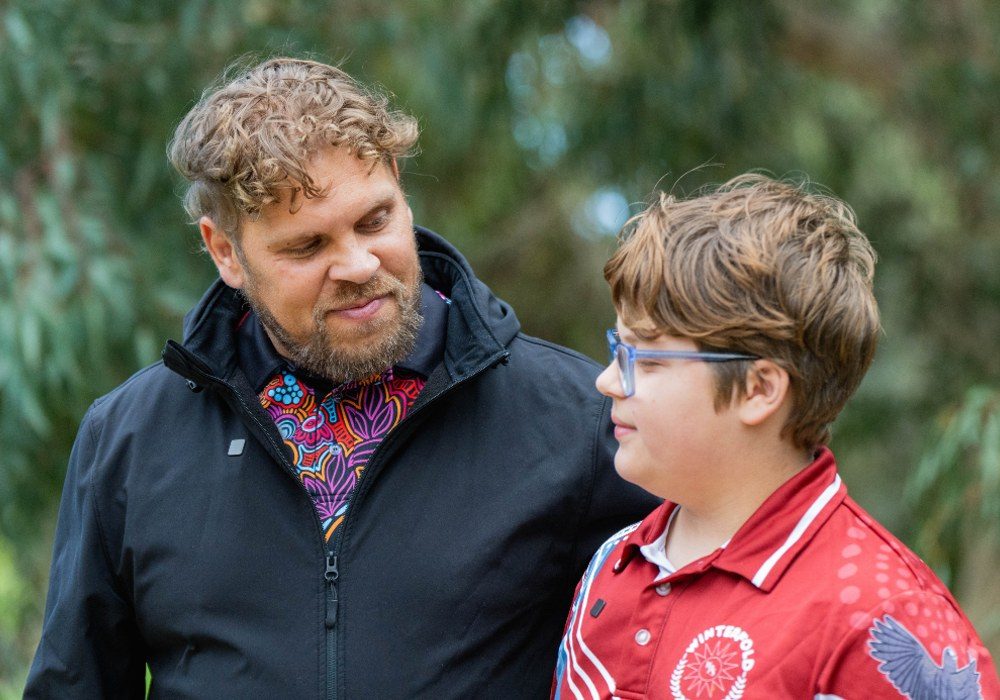The cross-cultural learning and excellence of Winterfold School in Fremantle, Western Australia has been celebrated for how its engagement and teaching of Noongar language has led to a unique relationship with its local Italian community.
Western Australia has a well-documented record of violence against First Nations peoples, but many West Australians are finding genuine and thoughtful ways to overcome this legacy by ensuring Aboriginal and Torres Strait Islander cultures are an indivisible part of its diverse community.
A small school near Fremantle has been recognised for its commitment to anti-racism, teaching Noongar language and culture and building links between the local Italian and Noongar communities it serves.
Winterfold Primary School won the schools category in the 2023 Narragunnawali Awards. The award recognises and celebrates Australian schools and early learning services that are implementing outstanding reconciliation initiatives.
Chair of the awards judging panel and Reconciliation Australia Board Director, Shaz Davis, said the school inspired the judges with its strong connections to its local Noongar community and a vigilant policy of anti-racism.
‘Winterfold’s Principal told the judges that reconciliation and anti-racism was at the core of the school’s culture and curriculum, and this was obvious to us all when we visited the school,’ they said.
‘The use of Noongar language and the school’s clearly warm and supportive relationship with Noongar Elders, parents and kids was wonderful to witness.’

Pride in Culture
Winterfold’s reconciliation journey really began in earnest in 2019 when a Reconciliation Committee composed of teachers, education assistants and Aboriginal and Torres Strait Islander parents developed its first Reconciliation Action Plan (RAP) using Reconciliation Australia’s Narragunnawali platform.
The RAP centred on the cross-curriculum teaching of Aboriginal and Torres Strait Islander histories and cultures.
School Principal, Kim Calabrese, said a commitment to truth-telling and open and honest conversations about injustices, which have occurred since colonisation, is pivotal to the school’s vision.
‘One of the first steps of the school’s reconciliation journey was to learn more about the Aboriginal Country on which the school stands, Beeliar Wadjak (Whadjuk) Noongar boodja (country) and its history,’ she told Reconciliation News.
‘Noongar language has become a prominent part of the learning environment, with signage across the school and sharing Noongar words in the parent newsletter, assemblies and in classrooms to support teaching and learning programs.
‘Students tell us that their families also want to learn the Noongar language and students are going home teaching their parents new words each fortnight.’
Kim Calabrese reports that First Nations student attendance at Winterfold outperforms other schools and student feedback from annual surveys reflects a sense of belonging and inclusion.
‘Our students are proud of their cultures, and this is evident in their willingness to share knowledge with other peers and teachers.’
Italian and Noongar – an affinity through language
Noongar is not the only language centred at Winterfold. Italian is taught as part of the Western Australian Curriculum.
With high numbers of Italian immigrants arriving in Perth and Fremantle from post-war Europe in the 1950s, Italian culture is also of great significance to the heritage of the area. Noongar language is shared with the school community alongside the teaching of Italian in the classroom.
Kathleen Turtur, a woman of Noongar and Italian heritage and parent of former student, Rueben Hayden-Nelson, said the mix of Italian and Noongar languages has worked to build better understandings between the two communities.
‘Noongar and Italian cultures are similar in many ways,’ she explains. ‘They are both extremely family-orientated and in both Noongar and Italian families, Elders are deeply respected
‘When my Nonna came to Australia from Sicily, she was told not to speak her own language and that she should adapt to the Australian culture in order to be accepted. I wish she had been able to hold onto her true identity and pass on her language to us.
‘The same was true for the Noongar side of my family. They were punished for speaking their traditional language. I didn’t have the opportunity to learn either of my heritage languages when I was at school, so I’m really glad my son was able to learn both at Winterfold.’
She agrees with Kim Calabrese that the school’s focus on Noongar language and culture has improved outcomes for First Nations and other children.
‘Now that culture and language are celebrated, there is pride in our kids. Culture is a big part of our identity and when our kids are free to express this they go in amazing directions.
‘Our kids are strong in their culture and this helps them daily.
‘Reuben was a quiet kid but when he was introduced to culture, dance and language he came out of his shell; his confidence grew so much he was able to stand up in front of the whole school and do an Acknowledgement of Country. We never thought he could do something like that,’ said Kathleen. ‘And now he’s even started teaching me new words in Noongar!’
According to Principal Calabrese the Winterfold community embodies a sense of family. ‘Everyone looks out for each other and genuinely cares about the success of all students which makes our school a truly exceptional and welcoming community to be a part of.’
And it seems the Winterfold family’s vision is making a tangible difference to its Aboriginal students.
‘Before Noongar culture and language was elevated to Winterfold there were kids getting into trouble and heading down the wrong road, said Kathleen Turtur. ‘But ever since the culture has been celebrated in the school, the kids are really feeling a part of the school because they are surrounded by culture. You’ll see kids really elevated and hold pride in what they do when their culture is respected, they feel safe.’
This article is from the 51st edition of Reconciliation News. Read the rest of the issue.
Narrgunnawali: Reconciliation in Education. There’s always more to learn.


